Review
CHAIN: A recasting of historical drama as contemporary
By Narumi Hiroshi
2022.03.14

CHAIN kicks off with a band of sword-clutching samurai racing through an obviously modern neighborhood engaged in furious combat. Screaming townspeople scatter along asphalt thoroughfares, and a group of fighters lying in wait appear to be doing so in a present-day soba noodle restaurant. Ah…we think, youths in chonmage top-knots materializing in modern-day Kyoto… a sight that leaves us mildly confused, not because it is novel, but because it reminds us of a scenario seen previously elsewhere, that of time slip or time travel. Or perhaps one of those period drama behind-the-scenes TV shows. Fleetingly we wonder if this is going to be yet another such hackneyed story. However as events progress, the story will turn out not to be what we suspected, because the characters eventually settle back properly into Edo-period surroundings, only in multiple scenes to also find themselves abruptly summoned into the modern-day city, and enduring this absurdity with taciturn fortitude. Slowly it dawns on us that this is a film about traveling back and forth between different times and spaces.
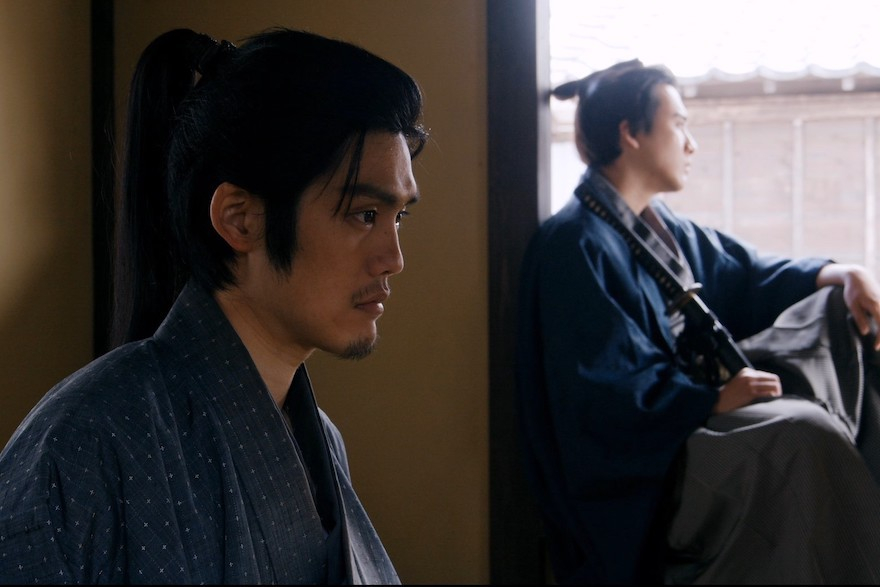 The film CHAIN could be described in the first instance as an historical or period drama (jidaigeki) revolving around the internal feuding of a group of imperial loyalists at the very end of the Edo era, depicting, with the inclusion of townspeople and an ensemble of society’s strugglers, the fate of samurai torn between supporting the Tokugawa shogunate, and overthrowing it. The opening scene apparently reproduces in the actual location the historical event known as the Aburanokoji Incident, in which Ito Kashitaro, who left the Shinsengumi (guards of Kyoto toward the end of the Tokugawa shogunate) and formed the Goryo-eji to protect the emperor’s palace, was assassinated, and the companions who came to retrieve his body also slain by waiting soldiers. Putting in place a backdrop/time and space befitting the era is one of the basics of jidaigeki production, so inserting a different point in history can be very unsettling for the viewer. The makers of this film take this risk anyway because it elucidates the idea of the film linking present and past.
The film CHAIN could be described in the first instance as an historical or period drama (jidaigeki) revolving around the internal feuding of a group of imperial loyalists at the very end of the Edo era, depicting, with the inclusion of townspeople and an ensemble of society’s strugglers, the fate of samurai torn between supporting the Tokugawa shogunate, and overthrowing it. The opening scene apparently reproduces in the actual location the historical event known as the Aburanokoji Incident, in which Ito Kashitaro, who left the Shinsengumi (guards of Kyoto toward the end of the Tokugawa shogunate) and formed the Goryo-eji to protect the emperor’s palace, was assassinated, and the companions who came to retrieve his body also slain by waiting soldiers. Putting in place a backdrop/time and space befitting the era is one of the basics of jidaigeki production, so inserting a different point in history can be very unsettling for the viewer. The makers of this film take this risk anyway because it elucidates the idea of the film linking present and past.
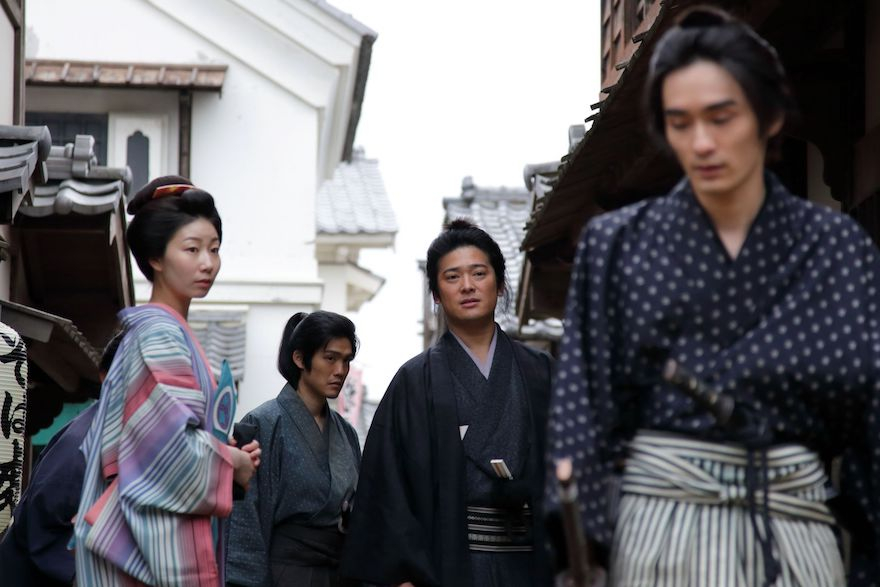 Note this film is also the eighth from the Kita-Shirakawa School Project, in which filmmakers teaching at Kyoto University of the Arts work alongside students to make movies that thus emerge from a mixing of older and new generations through filmmaking, and communicating things to each other. Apparently there is no rule that Kita-Shirakawa School films must be set in Kyoto, but many are indeed shot locally, resulting in works like Suzuki Takuji’s RANDEN: The Comings and Goings on a KYOTO Tram, which in a mingling of fact and fiction highlights stories from the neighborhoods along Kyoto’s private Keifuku Electric Railroad line. With its youths traveling back and forth between Reiwa (2019- ) and Keio (1865-1868) eras, CHAIN is another film that takes as its theme the layers of history in Japan’s former capital, and could fairly be described as being about the city.
Note this film is also the eighth from the Kita-Shirakawa School Project, in which filmmakers teaching at Kyoto University of the Arts work alongside students to make movies that thus emerge from a mixing of older and new generations through filmmaking, and communicating things to each other. Apparently there is no rule that Kita-Shirakawa School films must be set in Kyoto, but many are indeed shot locally, resulting in works like Suzuki Takuji’s RANDEN: The Comings and Goings on a KYOTO Tram, which in a mingling of fact and fiction highlights stories from the neighborhoods along Kyoto’s private Keifuku Electric Railroad line. With its youths traveling back and forth between Reiwa (2019- ) and Keio (1865-1868) eras, CHAIN is another film that takes as its theme the layers of history in Japan’s former capital, and could fairly be described as being about the city.
This vivid portrayal of the brutality of the Shinsengumi, who having murdered a former comrade in a stealth attack, then use his corpse as bait to annihilate a rival faction, sits within the tradition of films set in Kyoto at the end of the shogunate. Many have portrayed the bloodiness of coming of age during this period while simultaneously smashing Japanese jidaigeki stereotypes, including Kato Tai’s Bakumatsu zankoku monogatari (Fall of Feudal Times), a cruel historical drama in which the hero meets a tragic end; Shinoda Masahiro’s Assassination and Kuroki Kazuo’s The Assassination of Ryoma, which capture in grainy monochrome the fate of young men with big ambitions; and Oshima Nagisa’s Taboo, in which sexual love destroys the homosocial Shinsengumi. Compared to these earlier films, one senses in the samurai of CHAIN a strain of something milder. Most are the kind of people consigned to the obscure footnotes of history, and exhibit nothing approaching the arrogance of Tamba Tetsuro’s Kiyokawa Hachiro, or ferocity of Harada Yoshio’s Sakamoto Ryoma. These young men seem to be driven not by a hunger for control or some instinctive self-destructive urge, but a determination to somehow fulfil the role allotted them by history. Otherwise they would hardly make noises about hoping for a better Japan in 100 years, or opining that they’d be well rid of both samurai and emperor. Gambling their lives on hopes for the future gives them a benign quality uncharacteristic of characters in a late Edo period drama.
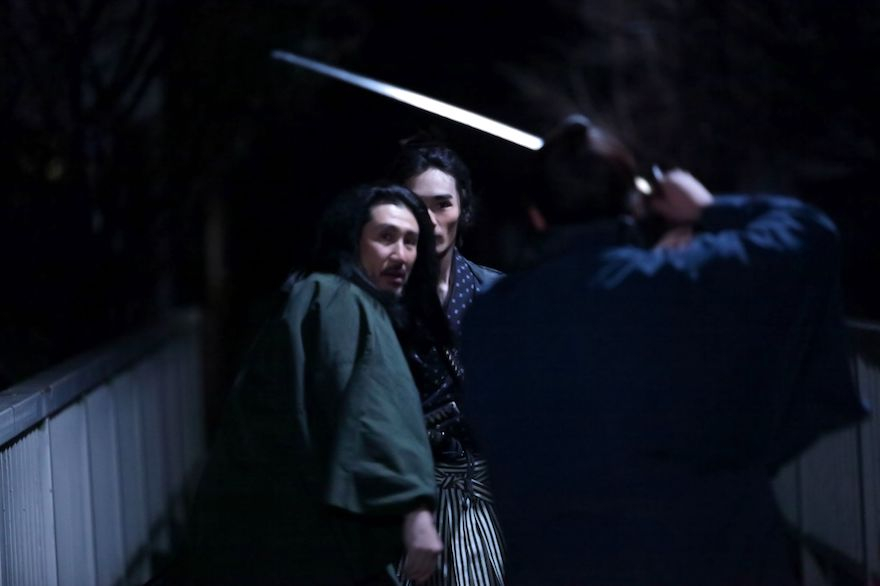 Ordinary townspeople also appear in the movie, and especially fascinating are the female characters shown living lives drained of all hope, such as the streetwalkers plying their trade under the Gojo Bridge (although there are also male prostitutes), and the woman trying to sell opium to samurai. The cries of these women, disillusioned with the world, living their fleeting lives in the moment, resonate in the mind more than the discontented mutterings of the warriors (apparently a number of female students helped to write the script, contributing to the formation of its characters).
Ordinary townspeople also appear in the movie, and especially fascinating are the female characters shown living lives drained of all hope, such as the streetwalkers plying their trade under the Gojo Bridge (although there are also male prostitutes), and the woman trying to sell opium to samurai. The cries of these women, disillusioned with the world, living their fleeting lives in the moment, resonate in the mind more than the discontented mutterings of the warriors (apparently a number of female students helped to write the script, contributing to the formation of its characters).
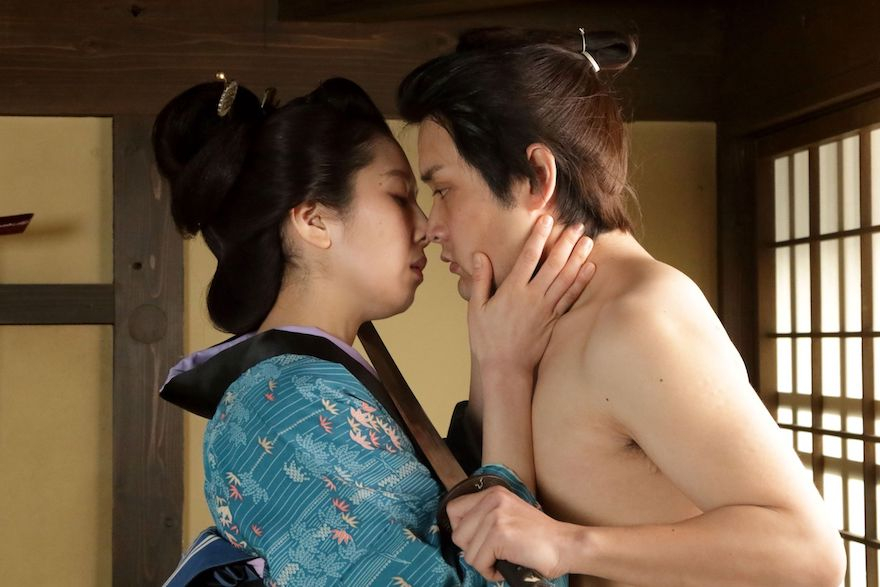
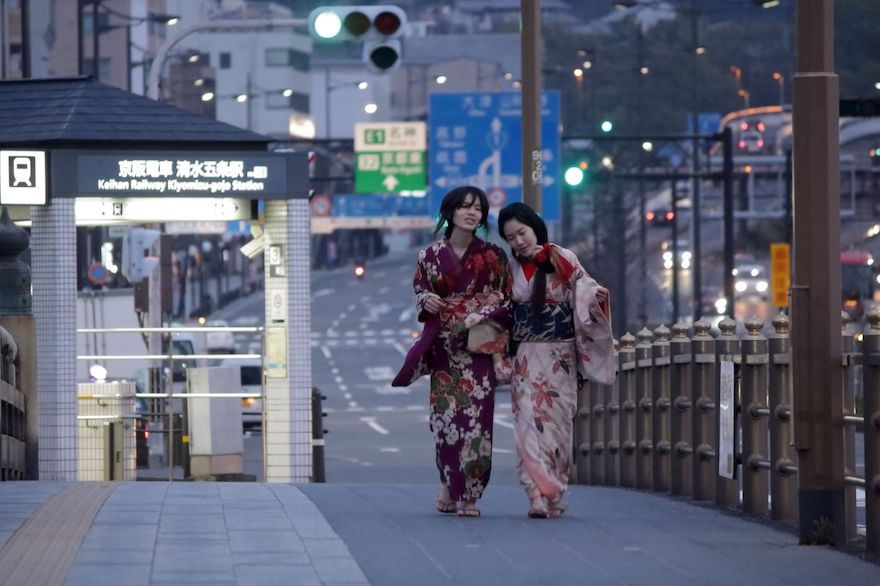
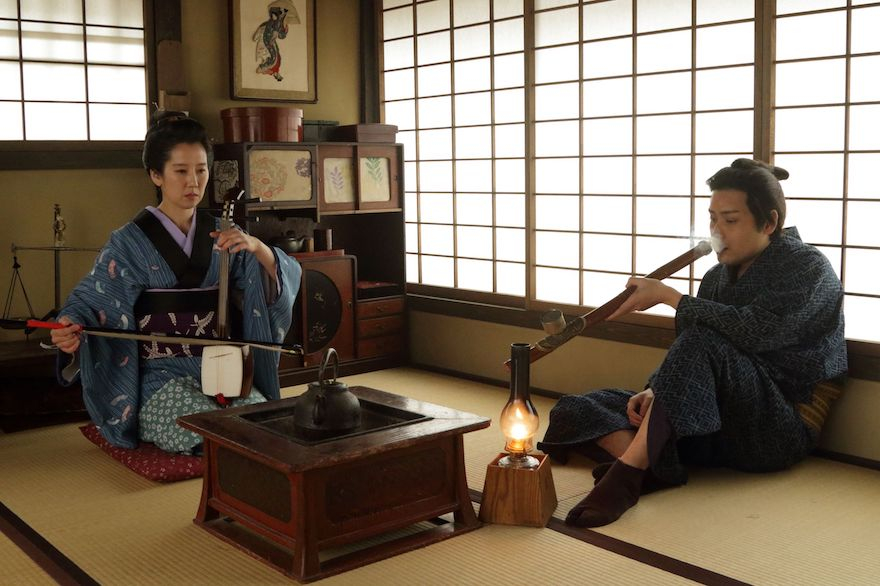 When it comes to more female-centered cinematic treatments of the closing Edo years, Gosho Heinosuke’s Glow of the Firefly is a work notable for the sorrows and strengths of women, being the story of the young mistress of the Teradaya Inn, who falls for Ryoma, but following a series of events ultimately gives up her attachment and accepts her fate. But in terms of its pessimism, Ishida Tamizo’s Fallen Blossoms depicting the destruction of the everyday lives of geisha in Gion at the hands of samurai, against a backdrop of the Kinmon no Hen (Forbidden Gate Incident), is perhaps closer to the women in CHAIN. Compared to the resigned acceptance of women closeted in inns and geisha houses, the resentment the women in this film exhibit toward men has a vaguely modern air. In saying this, the women in CHAIN are still no more than an adjunct to the males, and their portrayal also unfortunately a little on the dull and two-dimensional side.
When it comes to more female-centered cinematic treatments of the closing Edo years, Gosho Heinosuke’s Glow of the Firefly is a work notable for the sorrows and strengths of women, being the story of the young mistress of the Teradaya Inn, who falls for Ryoma, but following a series of events ultimately gives up her attachment and accepts her fate. But in terms of its pessimism, Ishida Tamizo’s Fallen Blossoms depicting the destruction of the everyday lives of geisha in Gion at the hands of samurai, against a backdrop of the Kinmon no Hen (Forbidden Gate Incident), is perhaps closer to the women in CHAIN. Compared to the resigned acceptance of women closeted in inns and geisha houses, the resentment the women in this film exhibit toward men has a vaguely modern air. In saying this, the women in CHAIN are still no more than an adjunct to the males, and their portrayal also unfortunately a little on the dull and two-dimensional side.
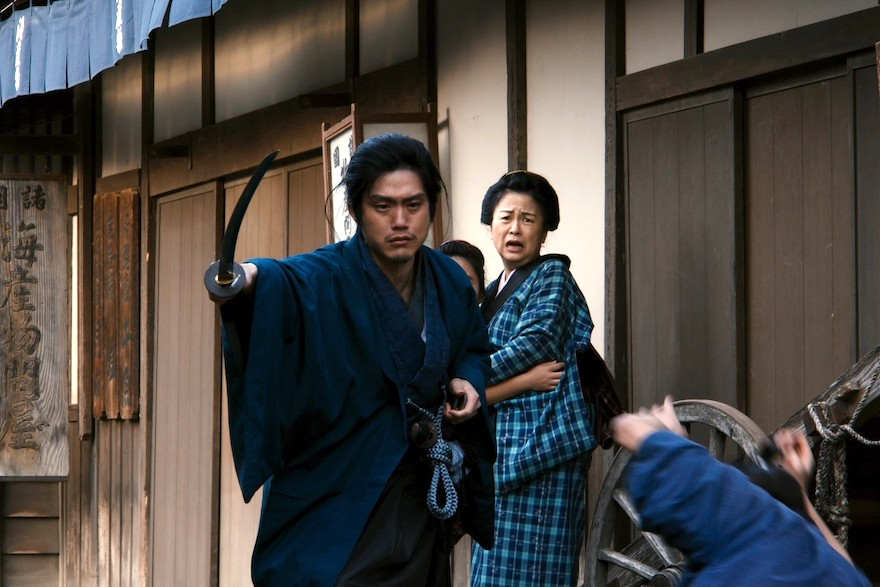 Director Fukuoka Yoshiho has remarked that his film is not so much historical drama as “time drama” (jikangeki). Meaning not a story set in a specific era, but an attempt to recreate across time the people who lived in this town, while conscious of the inherent fictionality of this. Seen in this light, CHAIN is an audacious contemporary recasting of the historical drama. Fukuoka is trying here to tune into the voices of less driven young men loitering quietly in a corner of history, and women consigned to historical oblivion. The Berlin angels of Wim Wenders (in Wings of Desire) tuned into the thrum of joy and sorrow and resignation in the souls of ordinary people living in that great metropolis, and recorded them. In the same manner, this film endeavors to pay detailed attention to the hum and thrum of people who once existed in Kyoto, a city that has lost so much to the turbulence of history. CHAIN is Fukuoka’s version of the “Angelus Novus.”
Director Fukuoka Yoshiho has remarked that his film is not so much historical drama as “time drama” (jikangeki). Meaning not a story set in a specific era, but an attempt to recreate across time the people who lived in this town, while conscious of the inherent fictionality of this. Seen in this light, CHAIN is an audacious contemporary recasting of the historical drama. Fukuoka is trying here to tune into the voices of less driven young men loitering quietly in a corner of history, and women consigned to historical oblivion. The Berlin angels of Wim Wenders (in Wings of Desire) tuned into the thrum of joy and sorrow and resignation in the souls of ordinary people living in that great metropolis, and recorded them. In the same manner, this film endeavors to pay detailed attention to the hum and thrum of people who once existed in Kyoto, a city that has lost so much to the turbulence of history. CHAIN is Fukuoka’s version of the “Angelus Novus.”


This vivid portrayal of the brutality of the Shinsengumi, who having murdered a former comrade in a stealth attack, then use his corpse as bait to annihilate a rival faction, sits within the tradition of films set in Kyoto at the end of the shogunate. Many have portrayed the bloodiness of coming of age during this period while simultaneously smashing Japanese jidaigeki stereotypes, including Kato Tai’s Bakumatsu zankoku monogatari (Fall of Feudal Times), a cruel historical drama in which the hero meets a tragic end; Shinoda Masahiro’s Assassination and Kuroki Kazuo’s The Assassination of Ryoma, which capture in grainy monochrome the fate of young men with big ambitions; and Oshima Nagisa’s Taboo, in which sexual love destroys the homosocial Shinsengumi. Compared to these earlier films, one senses in the samurai of CHAIN a strain of something milder. Most are the kind of people consigned to the obscure footnotes of history, and exhibit nothing approaching the arrogance of Tamba Tetsuro’s Kiyokawa Hachiro, or ferocity of Harada Yoshio’s Sakamoto Ryoma. These young men seem to be driven not by a hunger for control or some instinctive self-destructive urge, but a determination to somehow fulfil the role allotted them by history. Otherwise they would hardly make noises about hoping for a better Japan in 100 years, or opining that they’d be well rid of both samurai and emperor. Gambling their lives on hopes for the future gives them a benign quality uncharacteristic of characters in a late Edo period drama.





Narumi Hiroshi
Professor, Cultural studies, Kyoto Women’s University.
※Chain official website
www.chain-movie.com